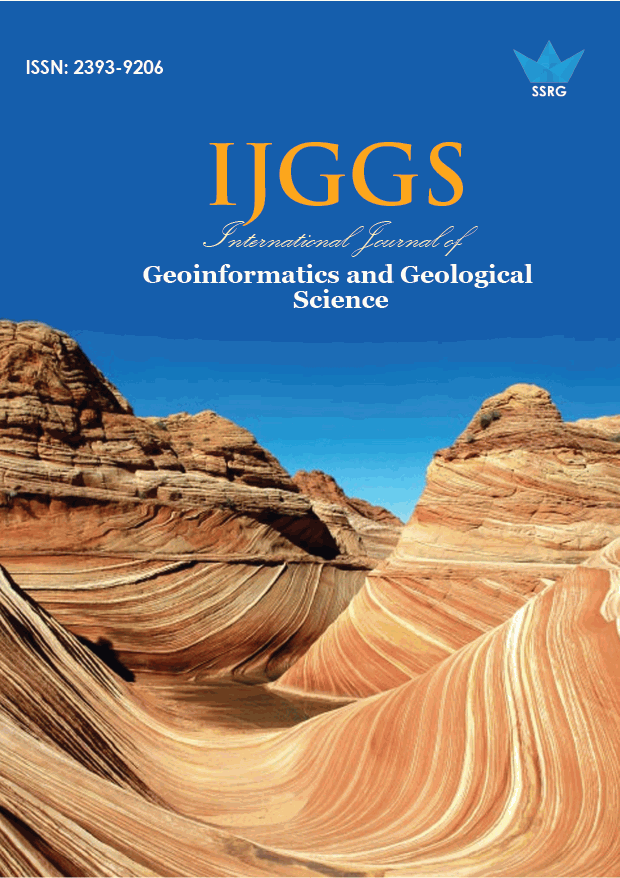Urbanization in India by using Remote sensing and GIS techniques

| International Journal of Geoinformatics and Geological Science |
| © 2016 by SSRG - IJGGS Journal |
| Volume 3 Issue 2 |
| Year of Publication : 2016 |
| Authors : S.Anandharaj, Dr.C.Sulaxna sharma |
How to Cite?
S.Anandharaj, Dr.C.Sulaxna sharma, "Urbanization in India by using Remote sensing and GIS techniques," SSRG International Journal of Geoinformatics and Geological Science, vol. 3, no. 2, pp. 1-5, 2016. Crossref, https://doi.org/10.14445/23939206/IJGGS-V3I4P101
Abstract:
In India, the complication in the process of urban development is so rapid that it demands quick response and perspective view of planning of the cities and towns. Consequently, it is essential and important for policy makers to integrate remote sensing into urban planning and management. Remote sensing is the surveillance and measurement of objects from a distance, i.e. instruments or recorders are not in direct contact with objects under exploration. Remote sensing mainly depends upon determining some kind of energy that is produced, transferred, or revealed from an object in order to decide certain physical properties of the object. Photography is the one among the important types of remote sensing techniques. The result of a remote sensing system is commonly an image demonstrating the scene being perceived. Meanwhile remote sensing may not afford all the information desired for a full-fledged assessment; many other spatial aspects are necessary to be incorporated with remote sensing data. This process of assimilation of threedimensional data and their combined remote sensing is broadly in Cartographic assessments. This paper proposes the remote Sensing techniques are enormously useful for selection of sites for specific facilities such as dispensaries, restaurants, solid waste clearance area and industry. Urban planning needs a large volume of data both at the time of planning and at the time of application of the plan to decide the status of the available abilities. Thus remote sensing techniques provide precise, orderly and reliable information for planning and management of a town or a city. Remote Sensing techniques are very useful for change detection analysis and selection of sites for specific amenities such as hospitals, restaurants, solid waste disposal and industry.
Keywords:
Urban development, remote sensing, GIS, Cartographic surveys.
References:
[1] Barnsley, M.J.; Barr, S.L. A graph based structural pattern recognition system to infer urban land use from fine spatial resolution land cover data. Environ. Urban Syst. 1997, 21, 209– 225.
[2] Phinn, S.; Stanford, M.; Scarth, P.; Murray, A.T.; Shyy, P.T. Monitoring the composition of urban environments based on the Vegetation-Impervious Surface-Soil (VIS) model by sub pixel analysis techniques. Int. J. Remote Sens. 2002, 23, 4131–4153.
[3] Yang, X. Remote Sensing and Geospatial Technologies for Coastal Ecosystem Assessment and Management; Springer: Berlin, German, 2011.
[4] Nemmour, H.; Chibani, Y. Multiple support vector machines for land cover change detection: An application for mapping urban extensions. ISPRS J. Photogram. Remote Sens. 2006, 61, 125–133.
[5] Woodcock, C.E.; Macomber, S.A.; Pax-Lenney, M.; Cohen, W.B. Monitoring large areas for forest change using Landsat: Generalization across space, time and Landsat sensors. Remote Sens.Environ. 2001, 78, 194–203.
[6] Jimenez-Munoz, J.C; Sobrino, J.A, A generalized singlechannel method for retrieving landsurface temperaturefrom remote sensing data. J. Geophys. Res. Atmos. 2003, 108, 4688– 4697.
[7] Stow, D.A.; Hope, A.; McGuire, D.; Verbyla, D.; Gamon, Remote sensing of vegetation and land-cover change in Arctic Tundra Ecosystems. Remote Sens. Environ. 2004, 89, 281–308.
[8] Yuan, X.; Sarma, V. Automatic urban water-body detection and segmentation from sparse ALSM data via spatially constrained model-driven clustering. IEEE Geosci. Remote Sens. Lett.2011, 8, 73–77.
[9] Juanle, W.; Xu, Y.; Jia, W.; Deng, F. Study on urbanization information rapid extraction technique in China coastal zone area based on remote sensing: Case in Yancheng City, Jiangsu Province, China. In Proceedings of the 2010 International Conference on Multimedia Technology (ICMT), Ningbo, China, 29–31 October 2010.
[10] Löfvenhaft, K.; Björn, C.; Ihse, M. Biotope patterns in urban areas: A conceptual model integrating biodiversity issues in spatial planning. Landsc.Urban Plan. 2002, 58, 223–240.
[11] Hodson, M.; Marvin, S. “Urban ecological security”: A new urban paradigm? Int. J. Urban Reg. Res. 2009, 33, 193– 215.
[12] Wilson, J.S.; Clay, M.; Martin, E; Stuckey, D.; Vedder- Risch, K. Evaluating environmental influences of zoning in urban ecosystems with remote sensing. Remote Sens. Environ. 2003. 86, 303–321.
[13] Liang, B.; Weng, Q.H. Assessing urban environmental quality change of Indianapolis, United States, by the remote sensing and GIS integration. IEEE J. Sel. Top. Appl. Earth Obs. Remote Sens. 2011, 4, 43–55.
[14] Woodcock, C.E.; Macomber, S.A.; Pax-Lenney, M.; Cohen, W.B. Monitoring large areas for forest change using Landsat: Generalization across space, time and Landsat sensors. Remote Sens.Environ. 2001, 78, 194–203.
[15] Celik, T. Unsupervised change detection in satellite images using principal component analysis and k-means clustering. IEEE Geosci. Remote Sens. Lett.2009, 6, 772–776.

 10.14445/23939206/IJGGS-V3I4P101
10.14445/23939206/IJGGS-V3I4P101